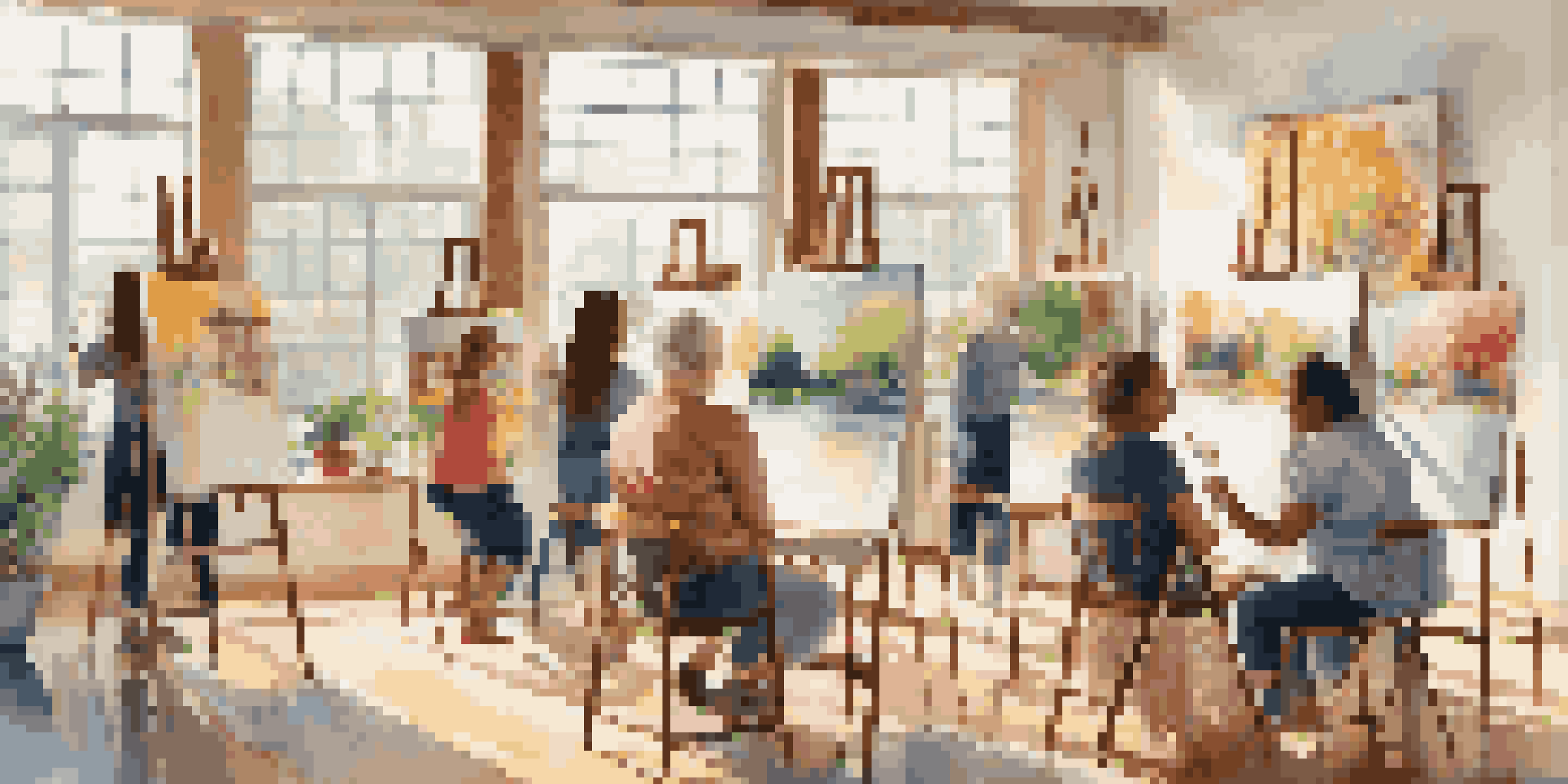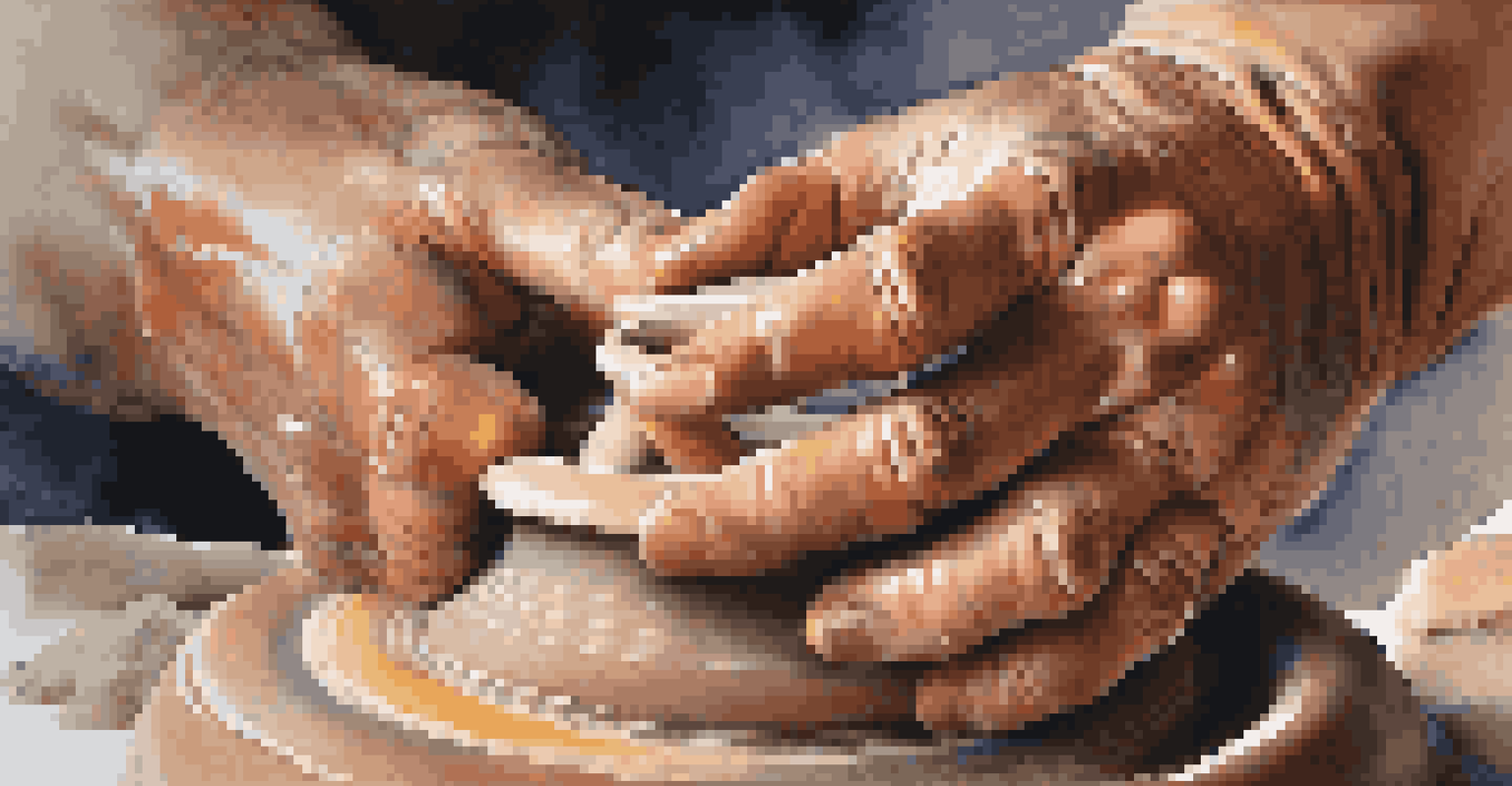Exploring the Therapeutic Benefits of Art in Emotional Health

Understanding Art Therapy and Its Purpose
Art therapy is a therapeutic approach that utilizes creative expression to help individuals process emotions. It combines the creative process of making art with psychological theories to promote emotional healing. Unlike traditional talk therapy, art therapy allows for non-verbal expression, making it accessible even for those who struggle to articulate their feelings.
Art is not what you see, but what you make others see.
The primary goal of art therapy is to provide a safe space for individuals to explore their emotions and experiences. Through various art forms, such as painting, drawing, or sculpting, participants can uncover deep-seated feelings and thoughts that might be challenging to express verbally. This process often leads to greater self-awareness and emotional insight.
Art therapy is not just for those with mental health conditions; it can benefit anyone seeking to enhance their emotional well-being. By engaging in creative activities, individuals can reduce stress, improve mood, and cultivate a sense of belonging. Ultimately, art therapy empowers people to embrace their emotions and foster personal growth.
The Science Behind Art and Emotional Healing
Research shows that engaging in creative activities can have profound effects on our emotional health. Studies have demonstrated that art-making can lower cortisol levels, which is a hormone associated with stress. When we create, our brains release dopamine, a neurotransmitter that contributes to feelings of pleasure and satisfaction, making art a natural mood booster.

Moreover, art therapy has been found to help individuals process trauma and grief. By translating painful experiences into visual forms, people can gain perspective and distance from their emotions. This transformative process can lead to significant breakthroughs, allowing individuals to move forward with their lives in a healthier way.
Art Therapy Promotes Emotional Healing
Art therapy combines creative expression with psychological insights to help individuals process emotions and foster personal growth.
The therapeutic effects of art are not limited to professional therapy settings; they can be experienced in everyday life. Activities like doodling, coloring, or even crafting can serve as emotional outlets. Engaging in these creative practices regularly can contribute to long-term emotional resilience and overall mental well-being.
How Art Facilitates Emotional Expression
Art serves as a universal language, allowing individuals to communicate feelings that may be difficult to articulate. For instance, a person dealing with anger may find it easier to express their emotions through bold brush strokes rather than through words. This non-verbal communication can be especially beneficial for children or those experiencing trauma who may lack the vocabulary to express their feelings.
Creativity takes courage.
Creating art encourages individuals to explore and confront their emotions in a safe environment. It allows for experimentation and play, which can lead to unexpected discoveries about oneself. This freedom to express without judgment can be incredibly liberating, fostering a deeper connection to one’s inner self.
In addition, sharing art with others can create a sense of community and support. Whether through group therapy sessions or art classes, individuals can find solace in knowing they are not alone in their experiences. This shared journey can enhance emotional healing and foster deeper connections with others.
Benefits of Art Therapy for Mental Health Conditions
Art therapy has proven to be effective for various mental health conditions, including anxiety, depression, and PTSD. By providing a creative outlet, individuals can express their thoughts and feelings in a way that feels safe and manageable. This can significantly reduce feelings of isolation and promote healing.
For those struggling with anxiety, engaging in art can serve as a calming practice. The focus required to create art can redirect attention away from anxious thoughts, providing a much-needed mental break. Many individuals report feeling more relaxed and centered after engaging in artistic activities.
Creative Expression Reduces Stress
Engaging in art activities can significantly lower stress levels, providing a calming escape and enhancing overall well-being.
Similarly, those dealing with depression may find that art therapy helps to improve their mood. The act of creating can foster a sense of accomplishment and purpose, counteracting feelings of hopelessness. By channeling emotions into art, individuals can also gain insight into their feelings, aiding in their recovery journey.
Art as a Tool for Stress Relief
In our fast-paced world, stress has become a common experience. Engaging in art can serve as a powerful tool for stress relief, offering a creative escape from daily pressures. Whether it’s through painting, drawing, or crafting, these activities can transport individuals to a peaceful, mindful state.
Creating art encourages mindfulness, the practice of being present in the moment. This focus can help individuals let go of worries about the past or future, allowing them to immerse themselves fully in the creative process. As a result, individuals often report feeling rejuvenated and more balanced after art-making sessions.
Moreover, the satisfaction that comes from completing a piece of art can further enhance mood and alleviate stress. The sense of achievement fosters a positive mindset, reinforcing the idea that engaging in creative activities can be a viable strategy for managing stress and enhancing overall well-being.
Incorporating Art into Your Daily Life
You don’t need to be an artist to benefit from the therapeutic effects of art. Incorporating creative activities into your daily routine can be simple and enjoyable. Consider setting aside a few minutes each day to doodle, paint, or even try adult coloring books, which have gained popularity for their stress-relieving qualities.
Another way to integrate art into daily life is to create a vision board. This fun activity involves cutting out images or words from magazines that resonate with your goals and aspirations. By visualizing your dreams in a tangible way, you can inspire motivation and positivity in your life.
Art Fosters Community and Connection
Sharing artistic experiences in group settings can create a sense of belonging, supporting emotional healing through shared journeys.
Additionally, joining a local art class or workshop can provide structure and social interaction, enhancing the emotional benefits of creating art. Being part of a community nurtures connections and support, further enriching the experience of artistic expression.
The Future of Art Therapy in Emotional Health
As awareness of mental health issues continues to grow, the role of art therapy in emotional health is becoming increasingly recognized. More mental health professionals are integrating art therapy into their practices, acknowledging its value as a complementary approach to traditional therapies. This integration can lead to more holistic treatment plans tailored to individuals' unique needs.
The rise of digital art also presents exciting opportunities for art therapy. With technology at our fingertips, individuals can explore creative outlets through various platforms and applications. This accessibility makes art therapy available to a broader audience, breaking down barriers to entry and encouraging more people to engage with their emotions creatively.

Looking ahead, the future of art therapy holds great promise. As research continues to uncover the benefits of art in emotional health, we can expect more programs and initiatives to emerge, further validating the importance of creativity in mental well-being. Embracing art as a therapeutic tool will undoubtedly continue to enhance emotional health for many.